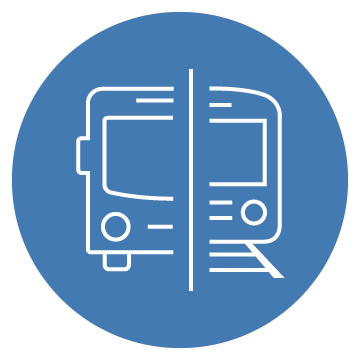
FISCAL
WMATA’s 2011 Making the Case for Transit: WMATA Regional Benefits of Transit (opens in new window) report found that for the DC Metro area:
- Property values within half-mile of Metrorail stations are valued at $235 billion.
- This land generates $3.1 billion annually in property tax revenues.
- This land represents 28% of the jurisdictions’ property tax base, but only 4% of their land.
- Proximity to Metrorail stations increases property values by 7-9%. WMATA estimates that these higher property values generate approximately $224 million in additional revenue from property taxes for areas within half-mile of stations.
Additionally, Metro reduces total household expenses by reducing transportation costs. Households can save money on both the cost of vehicle operation and car ownership by living close to a Metro station. WMATA estimates that the annual savings for families living near Metrorail station and/or bus corridors is $342M annually.
According to the Metropolitan Washington Council of Governments, Metro’s congestion-reducing benefits save businesses and employees over $1.2 billion per year.

ENVIRONMENTAL
TOD is good for the environment. Households and employees adjacent to transit are more likely to use transit, resulting in reduced auto use and lower GHG emissions. In certain areas, building TODs can actually reduce driving by up to 85%.
Additionally, WMATA estimates that choosing transit over driving alone prevents about 260 tons of volatile organic compounds, 22 tons of particulate matter, and 0.5 million tons of carbon dioxide from being released into the atmosphere in the DC Metro area. Monetizing these environmental benefits leads to an estimated cost savings in the region of about $9.5 million annually (in 2010 dollars).

MOBILITY
WMATA estimates that there are more than 2 million jobs within one-half mile of Metrorail stations and Metrobus stops in the DC region, and that there are 300,000 additional jobs within one mile of stations and bus stops. According to the Bureau of Labor Statistics, there are roughly 3.4 million jobs in the DC Metro region. This means that nearly 60 percent of jobs in the DC metro region are within walking distance of a Metrorail and/or bus stop. This makes TOD development in the region all the more critical, as it will allow more people opportunities to take convenient transit to and from work.
Collectively, WMATA has found that its transit services save residents nearly 148,000 hours per day that would otherwise be lost to sitting in traffic. Additionally, WMATA estimates that if the one million-plus trips that residents make on Metro transit services each day were converted to car trips, it would increase the region’s rush hour congestion by 25 percent.

ECONOMIC
According to WMATA’s Making the Case for Transit: WMATA Regional Benefits of Transit report, Metro supported over 10,970 jobs and estimated nearly 15,000 additional jobs associated with Metro operations in 2010. WMATA also looked at the impacts of new Metrorail stations on employment and the local economy. For example, after the NoMa Station opened in 2004, WMATA found that 15,000 jobs were created within the 35-block area around the station between 2001 and 2007. Additionally, property values rose significantly in the same area, from $535 million in 2001 to $2.3 billion in 2007.
WMATA found that, overall, being within close proximity to transit had a positive impact on property values for single and multi-family residential and office developments. This, in turn, allows jurisdictions to collect additional revenue in the form of property taxes to fund schools and public services from properties adjacent to transit.